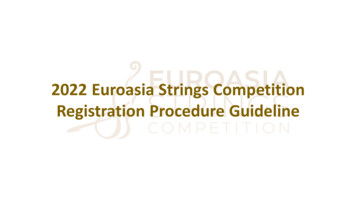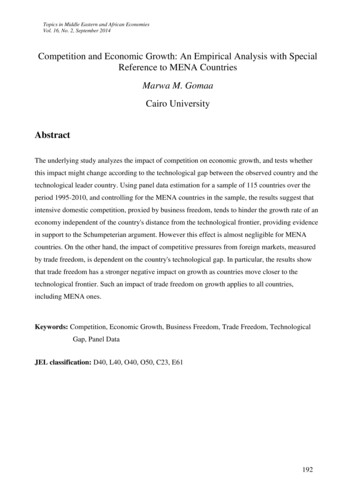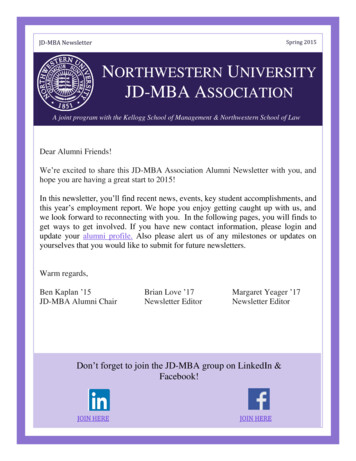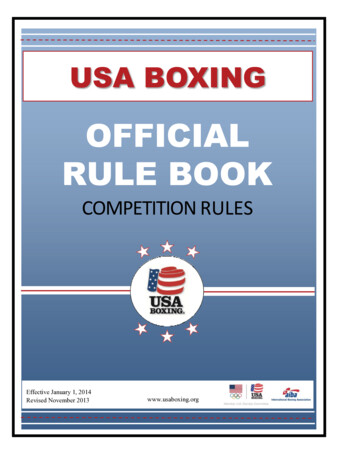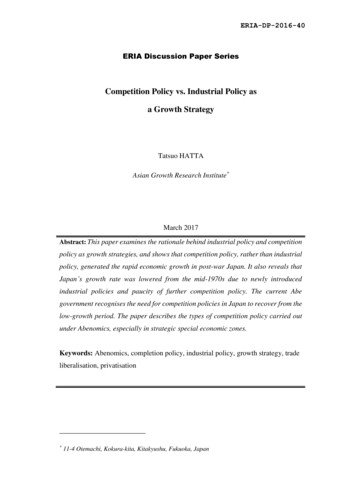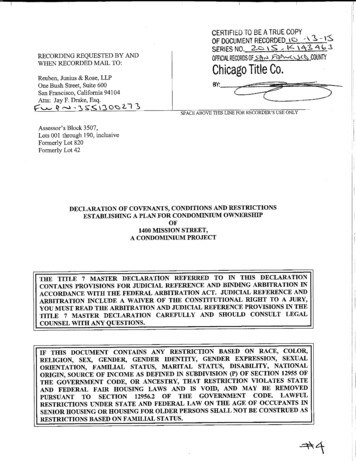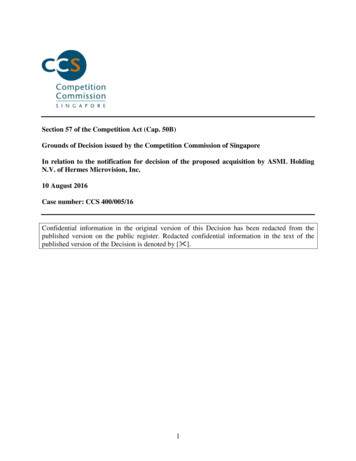
Transcription
Section 57 of the Competition Act (Cap. 50B)Grounds of Decision issued by the Competition Commission of SingaporeIn relation to the notification for decision of the proposed acquisition by ASML HoldingN.V. of Hermes Microvision, Inc.10 August 2016Case number: CCS 400/005/16Confidential information in the original version of this Decision has been redacted from thepublished version on the public register. Redacted confidential information in the text of thepublished version of the Decision is denoted by [ ].1
TABLE OF n . 3The Parties . 3The Transaction . 4Competition Issues . 6Counterfactual . 9Relevant Markets . 10Market Structure . 15Competition Assessment . 22Efficiencies . 29Conclusion. 292
I.Introduction1.On 28 June 2016, a joint notification under section 57 of the Competition Act (Cap. 50B)(the “Act”) was made by ASML Holding N.V. (“ASML”) and Hermes Microvision, Inc.(“HMI”) (collectively “the Parties”), for a decision by the Competition Commission ofSingapore (“CCS”) as to whether an anticipated acquisition by ASML of 100% of thevoting securities of HMI (the “Transaction”) will infringe the prohibition under section54 of the Act.2.In reviewing the Transaction, CCS has taken into consideration the views and feedbackfrom the Parties’ competitors and customers. Responses were received from six 1competitors and four2 customers. Substantive feedback was received from three thirdparties, and the remaining third-parties indicated that they either had no comments ordeclined to comment on the notified Transaction.3.After evaluating the submissions from the Parties, together with the views and feedbackfrom third-parties during the public consultation, CCS concludes that the Transaction willnot infringe the prohibition under section 54 of the Act.II.The PartiesASML4.ASML is an entity incorporated in the Netherlands, and is listed on Euronext Amsterdamand NASDAQ. ASML is the ultimate parent company of thirty-seven subsidiariesinvolved in the development, production, marketing, selling and servicing of advancedhigh-tech lithography, metrology and software solutions for the semiconductor industry(the “ASML Group”). The ASML Group is organised across three main business lines,namely: (i) deep ultraviolet lithography machines; (ii) extreme ultraviolet (“EUV”)lithography machines; and (iii) applications, which includes metrology activities, such asthe development and sales of an advanced wafer metrology system (YieldStar), as well asprocess control applications (software).35.ASML’s registered entities in Singapore include ASML Singapore Pte. Ltd., and CymerSingapore Pte. Ltd.46.ASML’s activities in Singapore comprise sales of lithography equipment, overlaymetrology equipment and process control software. ASML also provides maintenanceand customer services in Singapore.51[ ].[ ].3Paragraph 7.1 of Form M1.4Paragraph 10.1 of Form M1.5Paragraph 10.10 of Form M1.23
7.The Singapore turnover of ASML was approximately [ ]6 and the worldwide turnoverfor ASML was approximately 6.29 billion (approximately S 9.4 billion) 7 in thefinancial year ended 31 December 2015.HMI8.HMI is an entity incorporated in Taiwan and is listed on the Taipei Stock Exchange. HMIis the ultimate parent company of five subsidiaries (the “HMI Group”), and does notbelong to a larger corporate group. The HMI Group is engaged in the manufacturing of ebeam inspection tools for chip manufacturers worldwide.89.HMI does not have any registered entities in Singapore. HMI also has no offices orfacilities in Singapore, and does not undertake manufacturing or research anddevelopment (“R&D”) in Singapore. 9 HMI sells and distributes its e-beam inspectiontools directly to customers in Singapore. This is done by HMI’s sales team based inTaiwan. [ ].1010.The Singapore turnover of HMI was [ ]11 and the worldwide turnover for HMI wasNT 6.65 billion (approximately S 278 million) 12 in the financial year ended 31December 2015.III.The TransactionNature of the Transaction11.The Transaction involves the anticipated acquisition by ASML of 100% of the votingsecurities of HMI in consideration of cash and ASML’s voting securities, by way ofpurchase and exchange of shares under a share swap agreement. The Transaction isconditional upon satisfaction or waiver of certain conditions, including that relevantregulatory approvals, consents or clearances have been given for the completion of theTransaction. Post-Transaction, ASML will own 100% of the voting securities of HMI.136Exchange rate S / used is 1 to S 1.4969. Paragraph 13.3 of Form M1.Exchange rate S / used is 1 to S 1.4969. Paragraph 13.1 of Form M1.8Paragraph 7.3 of Form M1.9Paragraph 10.11 of Form M1.10Paragraph 1.1 of the Parties’ Response dated 13 July 2016 to CCS’s Request for Information (“RFI”) dated 5 July2016.11Exchange rate S /US used in Form M1 is US 1 to S 1.3573. Paragraph 13.4 of Form M1.12Exchange rate S /NT used in Form M1 is NT100 to S 4.1780. Paragraph 13.2 of Form M1.13Paragraphs 11.1 and 11.4 of Form M1.74
Commercial rationale of the Transaction12.The Parties submitted that they are active in the development and manufacturing ofequipment and software used by the semiconductor industry for the production ofintegrated circuits 14 (“ICs”), but their products intervene at different stages in thedevelopment and production process. The Parties further submitted that the Transactionwill allow the Parties to increase the speed of innovation of e-beam technology and toestablish an e-beam based inspection technology for use in IC manufacturing.1513.Specifically, CCS understands from ASML’s press release in relation to the Transactionthat:16“Our over-arching goal is to serve our customers even better and offer them the toolsthey need to achieve higher yields at the most advanced nodes. This acquisition isintended to make a strong product offering even stronger. [ ] HMI e-beammetrology will deliver accurate patterning information, which ASML can use tooptimize its powerful design and process models, a cornerstone of ASML’s successfulcomputational lithography business. In return those models can be used to guide theoptical and e-beam metrology in a cost-effective manner to characterize the mostrelevant features on the chip device. Ultimately, this information combined withASML modeling will provide the ability to adjust ASML’s scanners settings foroptimal operation in the customers’ factories. Therefore, the transaction fits very wellwithin ASML’s holistic lithography strategy. Furthermore, HMI has pioneered ebeam inspection systems that are specially designed for mask manufacturers toidentify pattern defects in Extreme Ultraviolet (EUV) resulting from the mask. Thiswill support the ramp of ASML’s EUV platform, set to be used for volume productionof semiconductors starting in 2018.”Merger under section 54 of the Act14.The Parties submitted that the Transaction falls within section 54(2)(b) of the Act.1715.Paragraph 3.6 of the CCS Guidelines on the Substantive Assessment of Mergers providesthat a merger under section 54(2)(b) of the Act occurs in the case of an acquisition ofcontrol. Control may be acquired over an undertaking when the acquiring party becomesthe holder of the rights, contracts or other means that entitle the holder to exercisedecisive influence over the activities of that undertaking. CCS considers that decisiveinfluence is generally deemed to exist if there is ownership of more than 50% of the14ICs are complex semiconductor devices that combine a large number of transistors and connectivity materialarranged in specific patterns to perform complex processing or storage functions. These semiconductor devicescontain transistor arrays build on pieces (round slices) of silicon, also known as wafers. Explanation provided atparagraph 18.4 of Form M1.15Paragraph 12.1 of Form M1.16ASML Press Release “ASML to Acquire HMI to Enhance Holistic Lithography Product Portfolio”, 16 June 2016.Source: tportfolio/en/s5869?rid 53782.17Paragraph 11.2 of Form M1.5
voting rights attributable to the share capital of an undertaking which are exercisable at ageneral meeting.1816.Based on the Parties’ submission that the Transaction involves the acquisition by ASMLof 100% of the voting securities of HMI and sole control of all the business of HMI, CCSis of the view that the Transaction constitutes a merger pursuant to section 54(2)(b) of theAct.IV.Competition Issues17.According to the Parties, their business activities are fully non-overlapping and there areno overlapping goods or services sold by the Parties globally (including in Singapore).19Neither of the Parties sells the other’s products. HMI’s products are not offered as part ofany packages offered by ASML. 20 The Parties also submitted that their supportingservices, e.g. maintenance and customer services are also fully non-overlapping.21Manufacturing process of ICs18.The Parties submitted that the manufacturing process of ICs is divided into two phases: (i)front-end processes; and (i) back-end processes.19.The actual production of ICs takes place during the front-end processes. 22 Thisproduction process takes place at highly complex manufacturing facilities where therequired circuitry is imprinted on the wafer (“wafer fabs” or simply “fabs”). Theequipment necessary for the front-end production process can be sub-divided into twovertically-related levels:(a)processing equipment, which are used for the actual production of ICs; and(b)process control equipment and software, which control, verify and tune theprocessing equipment or the wafer produced.2320.Further information on processing equipment and process control equipment andsoftware required for front-end processes is set out in Annex A.21.During the back-end processes, the wafers are diced (i.e., cut into individual piecescorresponding to the imprinted semiconductor devices), wiring is added and theindividual dices are packaged.24 The back-end process takes place at locations which are18Paragraph 3.10 of the CCS Guidelines on the Substantive Assessment of Mergers.Paragraph 15.1 of Form M1.20Paragraph 5.4 of the Parties’ Response dated 13 July 2016 to CCS’s RFI dated 5 July 2016.21Paragraph 15.1 of Form M1; and paragraph 7.1 of the Parties’ Response dated 13 July 2016 to CCS’s RFI dated 5July 2016.22Paragraph 18.6.1 of Form M1.23Paragraphs 18.8.1 to 18.8.2 of Form M1.24Paragraph 18.6.2 of Form M1.196
different from that for the front-end process and involves other types of equipment.2522.The Parties submitted that neither ASML nor HMI provides products or services used bycustomers in the back-end manufacturing process and neither of their equipment issuitable to be used in the back-end manufacturing process.26 Therefore, there is no actualor potential horizontal overlap or vertical relationship between ASML and HMI for anyback-end manufacturing processes, and the back-end process is not relevant for theTransaction.27Products of the Parties23.The Parties have submitted that their products intervene at different stages in thedevelopment and production process of ICs, i.e., the front-end process. 28 ASML’sactivities are mainly focused in the lithography cluster of the IC manufacturing process.ASML produces lithography processing equipment, an overlay metrology system andassociated process control software, and other process control software.29 HMI is activein a separate stage in the production chain of ICs. Specifically, HMI is involved in thedevelopment and supply of inspection tools and deviation classification software.3024.Set out below are the products related to ICs supplied by the Parties:(a)(b)With regard to lithography equipment: –(i)ASML sells the following lithography equipment in Singapore:TWINSCAN NXT, TWINSCAN XT, PAS 5000 (various subtypes). 31ASML manufactures all types of lithography machines ranging from lowend layer to high-end32 performance and technology;33 and(ii)HMI does not supply any type of lithography equipment.34With regard to overlay metrology equipment: –(i)ASML sells its overlay metrology equipment under the product name25Paragraph 18.7 of Form M1.Paragraph 8.1 of the Parties’ Response dated 13 July 2016 to CCS’s RFI dated 5 July 2016.27Paragraph 18.7 of Form M1; and paragraph 8.1 of the Parties’ Response dated 13 July 2016 to CCS’s RFI dated 5July 2016.28Paragraph 12.1 of Form M1.29Paragraph 18.2 of Form M1.30Paragraph 18.3 of Form M1.31Paragraph 14.1.1 of Form M1.32A fab usually has multiple lithography machines of varying levels of precision. Simple chips, i.e., single-featurechips such as heat or light sensors, are produced with low-end equipment. Advanced chips, for instance mainprocessors to be used in smartphones, require high-end and very precise production equipment. However, a high-endchip will also be built up with some low-end layers and mid-end layers, using low-end equipment and mid-endequipment, respectively. (Explanation provided at paragraph 18.11 of Form M1.)33Paragraph 10.5 of Form M1.34Paragraph 19.14 of Form M1.267
“YieldStar” in Singapore. 35 ASML’s overlay metrology tool is used aspart of the lithography process to ensure that the next structural level onthe wafer is applied spatially correct in relation to the previous ones;36 and(ii)(c)(d)25.HMI is not active on this market as it does not supply overlay metrologyequipment.With regard to process control software: –(i)ASML is focused on process control software specifically for thelithography cluster of a wafer fab. 37 ASML, through its wholly-ownedsubsidiary Brion Technologies, Inc. (“Brion”), is active in the area ofwafer design software, which is a type of software that helps to design thelay-out of ICs being manufactured and is therefore used in thedevelopment phase and not during the actual manufacturing process;38 and(ii)HMI has only developed classification software associated with its e-beaminspection tool, and ASML does not sell software that can be used as asubstitute to HMI’s software. Other than that, HMI does not offer anysoftware to customers.39With regard to wafer inspection equipment: –(i)ASML is not involved in the development and supply of inspectiontools;40 and(ii)HMI sells the following e-beam wafer inspection tools in Singapore:eScan Series (for voltage contrast inspection of three dimensional ICstructures), and eP Series (for hotspot and physical defect inspection).41HMI has also developed e-beam equipment especially designed for EUVmask (or ‘reticle’) inspection (eXplore Series) and has sold a few tools,but the Parties submitted that this product is not expected to take offbefore the commercialisation of EUV lithography machines.42In relation to supporting services, e.g. maintenance and customer services, the Partiessubmitted that these are also fully non-overlapping. ASML’s maintenance and customerservices are focused on ASML equipment and the process around it in the wafer fab.35Paragraph 14.1.2 of Form M1.Paragraph 12.8 of the Parties’ Response dated 13 July 2016 to CCS’s RFI dated 5 July 2016.37Paragraph 12.16 of the Parties’ Response dated 13 July 2016 to CCS’s RFI dated 5 July 2016.38Paragraph 12.17 of the Parties’ Response dated 13 July 2016 to CCS’s RFI dated 5 July 2016.39Paragraph 19.15 of Form M1; and paragraph 12.13 of the Parties’ Response dated 13 July 2016 to CCS’s RFIdated 5 July 2016.40Paragraph 19.16 of Form M1.41Paragraph 14.2.1 of Form M1.42Paragraph 10.9 of Form M1.368
HMI is doing the same with respect to HMI’s e-beam inspection tools.4326.CCS has assessed the Parties’ submissions and also verified whether there are any otheroverlapping businesses between the Parties. CCS notes that there are no overlappinggoods or services sold by the Parties globally, including in Singapore. In this respect,CCS has assessed whether the Transaction is likely to give rise to any substantiallessening of competition (“SLC”) concerns, in particular conglomerate effects, in anymarket in Singapore.V.Counterfactual27.As stated in paragraph 4.6 of the CCS Guidelines on Substantive Assessment of Mergers,CCS will, in assessing mergers and applying the SLC test, evaluate the prospects forcompetition in the future with and without the merger. The competitive situation withoutthe merger is referred to as the “counterfactual”. The SLC test will be appliedprospectively, that is, future competition will be assessed with and without the merger.28.The CCS Guidelines on Substantive Assessment of Mergers also states that in most cases,the best guide to the appropriate counterfactual will be prevailing conditions ofcompetition, as this may provide a reliable indicator of future competition without themerger. However, CCS may need to take into account likely and imminent changes in thestructure of competition in order to reflect as accurately as possible the nature of rivalrywithout the merger.44Parties’ submissions29.The Parties submitted that, in the absence of the Transaction, they will continue tooperate separately and independently. However, there will be a loss in opportunity for theParties to rationalise and achieve the efficiencies as described in Section IX below.45 TheParties also submitted that competitors are likely to continue to compete for customerswith, or without, the Transaction.46CCS’s assessment30.CCS is of the view that the prevailing conditions of competition would be the likelyscenario without the Transaction and this would accordingly be the counterfactual towhich the SLC test is applied.43Paragraph 7.1 of the Parties’ Response dated 13 July 2016 to CCS’s RFI dated 5 July 2016.Paragraph 4.7 of the CCS Guidelines on Substantive Assessment of Mergers.45Paragraph 23.1 of Form M1.46Paragraph 23.2 of Form M1.449
VI.Relevant Markets(a)Product MarketsParties’ submissions31.The Parties submitted that the relevant product markets are:(a)(b)(c)(d)32.lithography equipment;overlay metrology equipment;process control software; andwafer inspection equipment.47The Parties further submitted that it is not necessary to conclude on the exact delineation ofany sub-segments within each of these broader product markets.48Lithography equipment33.The Parties submitted that front-end processing equipment comprises sophisticated typesof equipment, each of which covers a specific stage in the manufacture ofsemiconductors.49 Lithography equipment, which is supplied by ASML but not HMI, isone of the main types of front-end processing equipment, and it is used to imprint aspecific pattern on the wafer (i.e., it is used to actually manufacture the ICs).5034.The Parties submitted that lithography equipment constitutes a separate relevant productmarket, as other types of processing equipment cannot perform the same functions aslithography machines.51 According to the Parties, from a supply-side perspective, it is notpossible to easily switch production lines from producing other types of processingequipment to the production of lithography machines.5235.According to the Parties, manufacturers of lithography equipment exert competitivepressure on each other, even though there may be a difference between the various typesof lithography machines (i.e., high-end, mid-end and low-end lithography machines). TheParties submitted that, there is ample room for substitution from a supply-sideperspective, and customers play a particularly important role with respect to the focusareas of lithography equipment manufacturers. Lithography machines which are used toimprint low-end, mid-end and high-end layers are all part of the same relevant productmarket and used in the same manufacturing process.53 The Parties submitted that high-47Paragraph 20.1 of Form M1.Paragraphs 19.21, 20.2 and 20.3 of Form M1; and paragraph 14.2 of the Parties’ Response dated 13 July 2016 toCCS’s RFI dated 5 July 2016.49Paragraph 18.9 of Form M1.50Paragraph 18.9.1 of Form M1; and paragraph 12.3 of the Parties’ Response dated 13 July 2016 to CCS’s RFIdated 5 July 2016.51Paragraph 12.4 of the Parties’ Response dated 13 July 2016 to CCS’s RFI dated 5 July 2016.52Paragraph 12.4 of the Parties’ Response dated 13 July 2016 to CCS’s RFI dated 5 July 2016.53Paragraph 14.1 of the Parties’ Response dated 13 July 2016 to CCS’s RFI dated 5 July 2016.4810
end equipment can technically be used to imprint low-end and/or mid-end layers,although this would be highly inefficient. The Parties added that it is technically notpossible to use low-end or mid-end equipment to imprint high-end layers, as theresolution of such equipment is not high enough.5436.The Parties also submitted that lithography equipment is not a type of metrology andinspection (“M&I”) equipment (see paragraph 37 below for more details on M&Iequipment).55Overlay metrology equipment37.The Parties submitted that M&I equipment, together with process control software,support processing equipment as part of the manufacturing process in a fab. M&Iequipment is used to detect deviations, defects and other irregularities that may harm thefunctioning of the IC. 56 Each type of M&I equipment services a separate step in theproduction process (see paragraph 8 in Annex A for details) and the techniques appliedmay vary depending on the subject of inspection and the required detail.57 All of the typesof M&I equipment are required by every semiconductor manufacturer for the process ofIC production.5838.Overlay metrology equipment, which is supplied by ASML but not HMI, is a type ofM&I equipment used to study patterned wafers during IC manufacturing.5939.According to the Parties, overlay metrology equipment constitutes a separate relevantproduct market, as other types of process control equipment cannot perform the samefunctions as overlay metrology equipment. 60 From a supply-side perspective, it is notpossible to easily switch production lines from producing other types of process controlequipment to the production of overlay metrology equipment.Process control software40.The Parties submitted that there are, broadly, two types of process control software: (i)software used to operate the processing equipment; and (ii) software that uses the outputof M&I equipment and provides feedback to optimise the settings of the processingequipment.61 In respect of the latter, the process control software may also use statisticaldata to optimise the settings of the processing equipment. For instance, virtual metrologyis used to predict wafer properties based on statistical methods without performing the54Paragraphs 1.1 and 1.2 of the Parties’ Response dated 1 August 2016 to CCS’s RFI dated 27 July 2016.Paragraph 19.12 of Form M1.56Paragraph 18.12 of Form M1.57Paragraph 19.13 of Form M1; and paragraph 12.12 of the Parties’ Response dated 13 July 2016 to CCS’s RFIdated 5 July 2016.58Paragraph 4.2 of the Parties’ Response dated 1 August 2016 to CCS’s RFI dated 27 July 2016.59Paragraph 18.16.1 of Form M1; and paragraph 12.8 of the Parties’ Response dated 13 July 2016 to CCS’s RFIdated 5 July 2016.60Paragraph 12.9 of the Parties’ Response dated 13 July 2016 to CCS’s RFI dated 5 July 2016.61Paragraph 19.5 of Form M1.5511
physical measurement itself.6241.The Parties further submitted that every step of the production process for ICs requiresspecific process control software, and various types of process control software cannot beused to perform the same function. It is also not possible to make a very clear-cutdistinction between the various types of process control software, in particular, if suchsoftware is not directly associated with a particular type of equipment.6342.ASML develops and supplies software for many applications in the semiconductorindustry, including software that is not directly associated with a specific type ofequipment. 64 However, ASML does not sell software that competes with HMI’ssoftware.6543.HMI’s activities with regard to software are limited as HMI has only developedclassification software associated with its e-beam inspection tool. HMI’s software is not astandalone product that is sold separate from HMI’s e-beam tool. In this regard, HMI isnot a specialised software developer that develops software for many differentapplications.66Wafer inspection equipment44.The Parties submitted that wafer inspection tools, which are supplied by HMI but notASML, are used to check the IC structures for critical deviations and otherirregularities.67 Wafer inspection takes place after the lithography process, after etching,after the deposition process and after the chemical-mechanical planarization (“CMP”)process, with each inspection step requiring a specific type of measurement and tools.6845.According to the Parties, there are two types of wafer inspection equipment:46.(a)Optical inspection equipment. This type of equipment is less sensitive (orprecise) than e-beam technology inspection equipment), although the inspectionspeed is much faster and the cost is lower; and(b)E-beam inspection equipment. The sensitivity of this type of equipment is betterthan optical inspection equipment, but the inspection speed is much slower andthe cost is higher.69The Parties submitted that, optical inspection technology is currently the mainstreamtechnology for wafer inspection. With the adoption of new semiconductor materials, new62Paragraph 18.14 of Form M1.Paragraph 19.15 of Form M1.64Paragraph 19.15 of Form M1.65Paragraph 19.7 of Form M1.66Paragraphs 19.15, 20.3 and 21.2 of Form M1.67Paragraph 19.8 of Form M1.68Paragraph 18.16.3 of Form M1.69Paragraphs 19.16.1 and 19.16.2 of Form M1.6312
processing technologies and the continuing shrinking of semiconductors, there is agrowing demand for very high resolution in the manufacturing process of very high-endsemiconductors.70 This leads to the development of alternative technologies that allow forhigh resolution. E-beam technology is an alternative technology for inspection of thesesmaller structures.7147.The Parties expect optical inspection technology to remain as the mainstream technologyfor wafer inspection, at least in the short to mid-term (five to 10 years). The Parties addedthat optical inspection tools are able to inspect IC structures down to 14 nanometre(“nm”), and possibly lower. ASML expects that IC features below 14 nm will enter intocommercial production during the year 2017.72 The Parties noted that e-beam inspectiontools are only expected to gain a larger market penetration as the customers (i.e., chipmanufacturers) transition to the next technology stages (“nodes”) in which the ICstructures are becoming increasingly smaller. However, according to the Parties, even inrespect of such smaller IC structures, it is expected that it is still feasible to use opticalinspection equipment for the large dimension patterns or non-critical layers of a wafer. Inaddition, optical inspection equipment manufacturers continue to develop advancedoptical technology to improve the sensitivity of the equipment.73CCS’s assessment of the relevant product markets48.CCS has considered the Parties’ submissions. Third-party feedback received by CCScorroborates the Parties’ submissions that lithography equipment, overlay metrologyequipment, process control software and wafer inspection equipment constitute distinctproduct markets.7449.In light of third-party feedback and the Parties’ submissions which indicate that differenttypes of lithography equipment and different types of wafer inspection tools havedifferent applications, 75 CCS has also considered the possibility of narrower productmarket definitions for lithography equipment (i.e., high-end, mid-end and low-endlithography equipment) and wafer inspection equipment (i.e., optical inspectionequipment and e-beam inspection equipment). However, as there are no overlappinggoods or services sold by the Parties globally, including in Singapore, CCS is of the viewthat it is not necessary to conclude on precise product market definitions in this case.CCS further notes that, regardless of whether narrower market definitions are adopted forlithography equipment and/or wafer inspection equipment product markets, CCS’sconclusion following its assessment (as set out below) would be the same.70Paragraph 19.17 of Form M1.Paragraph 19.18 of Form M1.72Paragraph 9.1 of the Parties’ Response dated 1 August 2016 to CCS’s RFI dated 27 July 2016.73Paragraph 19.20 of Form M1.74Responses from [ ].75Response from [ ]; and paragraph 18.19 of Form M1.7113
(b)Geographic MarketsParties’ submissions50.The Parties submitted that the geographic market for the relevant product markets set outin paragraph 31 above are worldwide in scope, as suppliers and customers of processingequipment, process control equipment and process control software operate, supply andsource their products and services around the world and consequently have branchesworldwide.76CCS’s assessment of the relevant geographic markets51
N.V. of Hermes Microvision, Inc. 10 August 2016 Case number: CCS 400/005/16 Confidential information in the original version of this Decision has been redacted from the published version on the public register. Redacted confidential information in the text of the published version of the Decision is denoted by [ ].





